Title: The Mirror of Literature, Amusement, and Instruction Volume 10, No. 277, October 13, 1827
Author: Various
Release Date: May 30, 2005 [EBook #15944]
Language: English
Character set encoding: ASCII
*** Start of this project gutenberg EBOOK the mirror of literature ***
Produced by Jonathan Ingram, David Garcia and the
Online
Distributed Proofreading Team.
* * * * *
The mirror of literature, amusement, and instruction.
Vol. X, no. 277.] Saturday, October 13, 1827. [Price 2d.
* * * * *
[Illustration: The Palace at Stockholm.]
THE PALACE AT STOCKHOLM.
The palace at Stockholm is the redeeming grace of that city.—Stockholm “not being able to boast any considerable place or square, nor indeed any street wider than an English lane; the exterior of the houses is dirty, the architecture shabby, and all strikes as very low and confined. Yet the palace must be excepted; and that is commanding, and in a grand and simple taste.” Such is the description of Stockholm by Sir Robert Ker Porter; but, as he admits, he had just left the city of St. Petersburgh, and being probably dazzled with the freshness of its splendour, Stockholm suffered in the contrast.
But Sir R.K. Porter is not entirely unsupported in his opinion. Mr. James, in his interesting “Journal of a Tour in Sweden, &c.” published in 1816, describes the suburbs of Stockholm as “uniting every beauty of wild nature, with the charms attendant upon the scenes of more active life; but the examples of architecture within the town, if we except the mansions of the royal family, are not of a style at all corresponding with these delightful environs. The private houses make but little show; and the general air of the public buildings is not of the first style of magnitude, or in any way remarkable for good taste. One point, however, may be selected, that exhibits in a single prospect all that the capital can boast of this description. There is a long bridge of granite, connecting the city in the centre with the northern quarters of the town: immediately at one extremity rises the royal palace, a large square edifice, with extensive wings, and of the most simple and elegant contour; the other extremity is terminated by an equestrian statue of Gustavus Adolphus, forming the chief object of a square, that is bounded on the sides by handsome edifices of the Corinthian order; one the palace of the Princess Sophia, the other the Italian Opera-house.”




